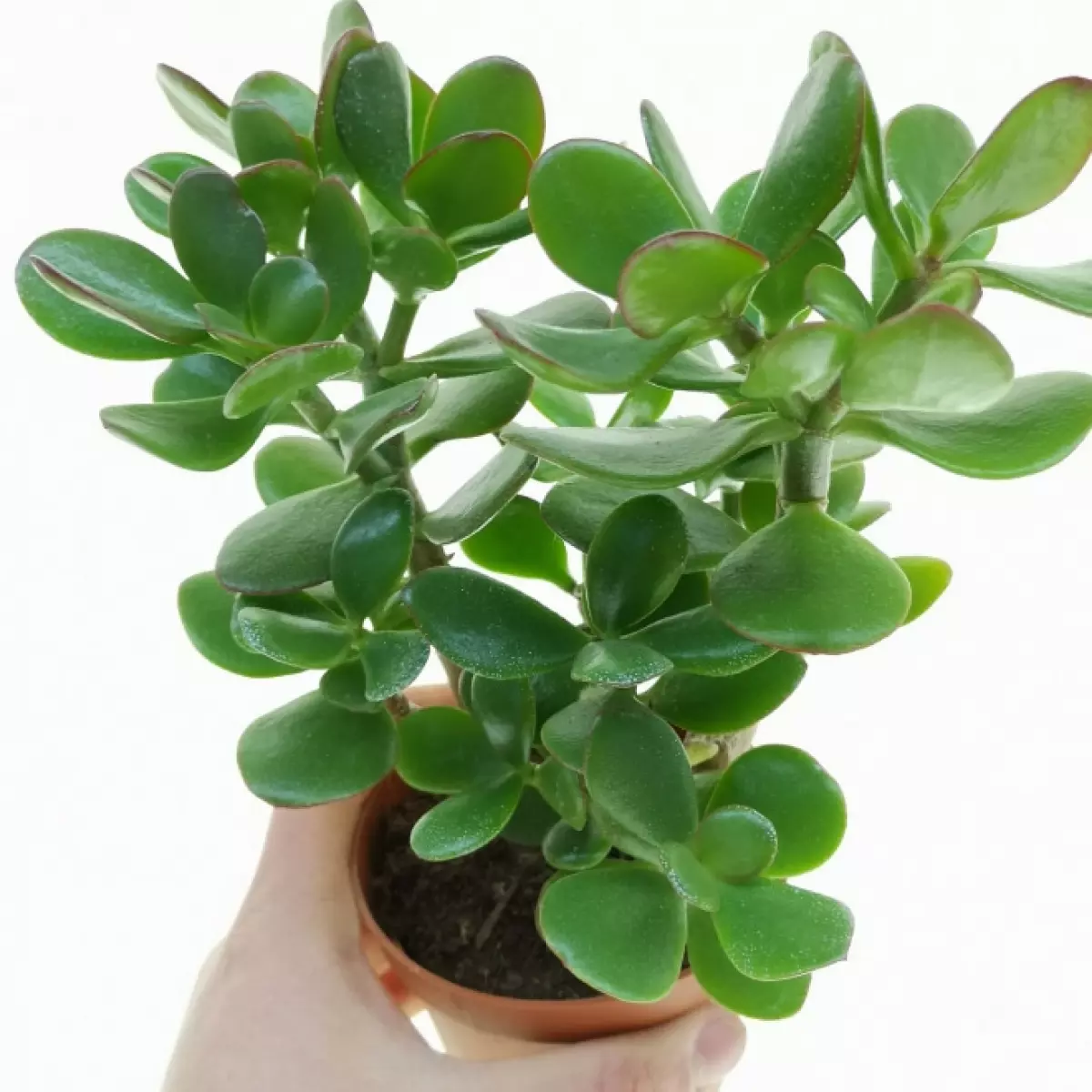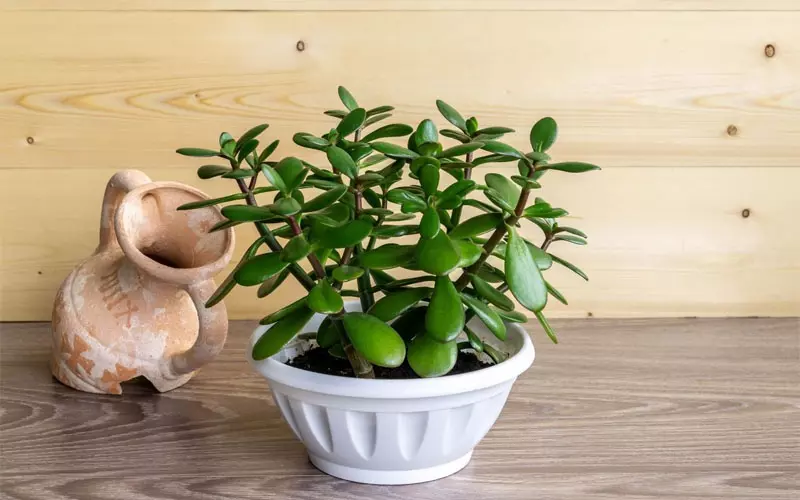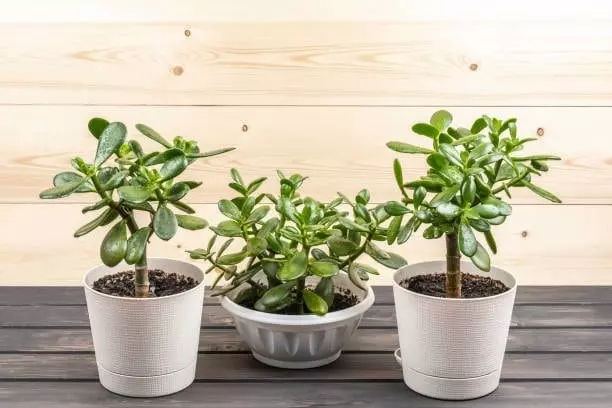As an expert in Feng Shui, I am thrilled to share with you the fascinating meaning and benefits of the jade plant. Originating from South Africa, the jade plant, scientifically known as Crassula ovata, is a succulent plant renowned for its thick, round leaves that can store water, enabling it to thrive in arid conditions.
Beyond its beauty, the jade plant has a special place in the world of Feng Shui. Often referred to as the "Money Plant" or the "Lucky Plant," it is believed to attract wealth, prosperity, and good fortune. In this article, we will explore the significance of the jade plant in Feng Shui, how to care for it, and its mysterious abilities.
The Significance of the Jade Plant in Feng Shui
 Jade Plant helps to attract wealth and luck for the homeowner.
Jade Plant helps to attract wealth and luck for the homeowner.
In the practice of Feng Shui, which focuses on creating harmony and balance in our surroundings, the jade plant holds a significant place. Just like its namesake gemstone, the jade plant symbolizes prosperity, success, and luck. Its thick and succulent leaves represent the accumulation of wealth, as water in Feng Shui is closely associated with prosperity.
Moreover, the jade plant is believed to counteract negative energy, protecting your wealth and happiness when placed strategically. To maximize its beneficial effects, it is essential to place the jade plant in the Southeast corner of your house or workspace, known as the "Wealth and Abundance" area according to the Bagua map. Combining the plant with other elements like a fish tank or mirror can enhance its power.
How to Utilize the Jade Plant in Feng Shui for Wealth and Luck
 Placing a pot of Jade plant near the entrance helps attract wealth and prosperity.
Placing a pot of Jade plant near the entrance helps attract wealth and prosperity.
To tap into the mystical power of the jade plant, proper placement is crucial. By positioning it in the Southeast corner, you allow its energy to flow harmoniously in the "Wealth and Abundance" area. Additionally, consider complementing the jade plant with other elements like a fish tank or mirror to amplify its attraction power.
The round, succulent leaves of the jade plant resemble coins, symbolizing wealth and abundance. To enhance its luck-bringing abilities, keep the leaves plump and shiny. Some believe that tying a red ribbon around the pot can further increase its wealth-attracting power.
However, remember that the jade plant is a living entity and requires care. Provide it with proper sunlight, well-draining soil, and water it when the soil is dry. Treat it with love, and it will reciprocate by aiding your luck and wealth.
Essential Tips for Caring for the Jade Plant Indoors

When growing the jade plant indoors, there are a few key factors to consider for its well-being. Firstly, ensure that you plant it in well-draining soil, preferably a cactus or succulent mix. Choose a pot with drainage holes to prevent waterlogged roots.
The jade plant thrives in bright, indirect sunlight, so find a suitable spot near a south or west-facing windowsill. Be cautious of direct, scorching sunlight that can cause leaf damage. If necessary, move the plant to a shadier location.
As a succulent, the jade plant can store water in its leaves. Water it when the soil is completely dry, allowing the water to thoroughly soak the roots. In cooler months, reduce watering as the plant goes into a dormant period.
Maintain a temperature range of 65°F to 75°F (18°C to 24°C) during the day, with slightly cooler temperatures at night. Avoid exposing the plant to drafts and sudden temperature changes, as it is sensitive to cold conditions.
During the growing season (spring and summer), feed your jade plant with a balanced, water-soluble fertilizer diluted to half strength. However, refrain from fertilizing during the dormant period.
By following these care tips, you can ensure that your jade plant thrives and continues to bring luck and prosperity into your space.
Addressing Common Jade Plant Issues
 Leaf drop and root rot are common issues with Jade plants.
Leaf drop and root rot are common issues with Jade plants.
While the jade plant is generally easy to care for, it may encounter certain challenges. By being aware of these issues and addressing them promptly, you can help your jade plant stay healthy and vibrant.
-
Root rot: Overwatering is a common cause of root rot in jade plants. To prevent this, ensure that the soil is well-draining and allow it to dry out completely between waterings.
-
Pests: Although jade plants are not highly susceptible to pests, they can occasionally attract insects such as mealybugs and spider mites. Regularly inspect your plant and take appropriate measures if you notice any infestation.
-
Leggy growth: If your jade plant starts to appear stretched or leggy, it may be an indication that it requires more sunlight. Consider moving it to a brighter location or supplementing with a grow light.
-
Leaf drop: Underwatering, overwatering, and temperature stress can lead to leaf drop in jade plants. Check the soil moisture, adjust your watering routine, and ensure stable environmental conditions to prevent excessive leaf loss.
-
Slow or stunted growth: While jade plants are not known for their rapid growth, they should still demonstrate steady progress. If your plant seems to be stagnant, try fertilizing it with a balanced formula during the growing season.
By understanding and addressing these common issues, you can help your jade plant flourish and thrive.
The Multiple Benefits of Having a Jade Plant
 There are many practical benefits to growing a Jade Plant indoors.
There are many practical benefits to growing a Jade Plant indoors.
In addition to its auspicious symbolism in Feng Shui, the jade plant offers a multitude of other advantages:
-
Air purification: Like many plants, jade plants contribute to improving indoor air quality by absorbing pollutants and releasing oxygen, creating a healthier living environment.
-
Stress relief: The presence of indoor plants, including the jade plant, has been shown to reduce stress levels and promote relaxation and happiness. Caring for these plants provides a therapeutic experience.
-
Low maintenance: Known for their hardiness and adaptability, jade plants are suitable for both experienced gardeners and beginners. They require minimal care, thriving in well-draining soil, bright but indirect sunlight, and tolerating occasional neglect.
-
Aesthetic appeal: With its glossy leaves and tree-like appearance, the jade plant adds natural beauty to any indoor space. It complements various interior design styles, creating a soothing and visually pleasing atmosphere.
-
Easy propagation: Jade plants are simple to propagate from leaves or stem cuttings, making it easy to grow new plants and share them with others.
As a Feng Shui expert and a plant enthusiast, the jade plant holds a special place in my heart. Not only does it bring luck and wealth, but it also offers numerous other benefits, making it an ideal and captivating addition to any living space.
Frequently Asked Questions
Why is my Jade Plant losing leaves?
Leaf drop is a common occurrence among plants and can cause concern for many plant owners. If your jade plant is losing leaves, there are a few potential causes to consider:
-
Overwatering: If the leaves are dropping from the bottom up, it could indicate overwatering. Jade plants do not require frequent watering and prefer to stay on the dry side. Check the soil moisture and adjust your watering habits accordingly.
-
Underwatering: If the leaves are dropping from the top down, underwatering may be the culprit. Although jade plants are drought-tolerant, they still need occasional watering. Ensure that you water the plant when the soil is dry.
-
Lack of sunlight: Insufficient sunlight exposure can also cause leaf drop in jade plants. While they can tolerate low light conditions, some exposure to sunlight is necessary for their growth. Ensure that your plant receives enough indirect light.
How often should I water my Jade Plant?
Watering requirements for jade plants depend on several factors, including temperature, humidity, pot size, and sunlight exposure. As a general guideline, wait until the soil is completely dry before watering. Stick your finger into the soil to check its moisture level. If it feels dry to the touch, it's time to water your plant. However, if the soil is still moist, wait a few more days before watering again.
Jade plants are succulents and can store water in their leaves and stems, allowing them to survive longer periods without water. Overwatering can lead to root rot and other issues, so it's best to water your jade plant once every two to four weeks.
How do I propagate a Jade Plant?
Propagating a jade plant is a rewarding experience, and there are a few methods you can try. One of the easiest ways is by taking stem cuttings. Simply cut a stem from the main plant, ensuring that it includes a few leaves. Allow the cutting to dry before planting it in a well-draining potting mix. Keep the soil moist but not wet, and you should see new growth within a few weeks.
Another method is division, which works best for mature jade plants with multiple stems. Gently separate the stems and ensure that each stem has its own set of roots. Replant each stem in its own pot with fresh soil.
The ideal time to propagate jade plants is during the active growing season in spring or summer.
Are Jade Plants toxic to pets?
Unfortunately, jade plants contain a toxic compound called bufadienolides, which can cause nausea, diarrhea, and even coma in pets if ingested in large amounts.
While jade plants are considered mildly toxic, it is best to keep them out of reach of pets, especially dogs and cats that may chew on plants. Place your jade plant on a high shelf or in an inaccessible room if you have pets in your house. If you notice any signs of poisoning, such as vomiting, diarrhea, or lethargy, seek immediate veterinary care.
The jade plant is a fascinating and beneficial addition to any home, both for its aesthetic charm and the positive energy it brings into your life. By caring for your jade plant and harnessing its Feng Shui properties, you can create an environment that promotes luck, wealth, and well-being.













